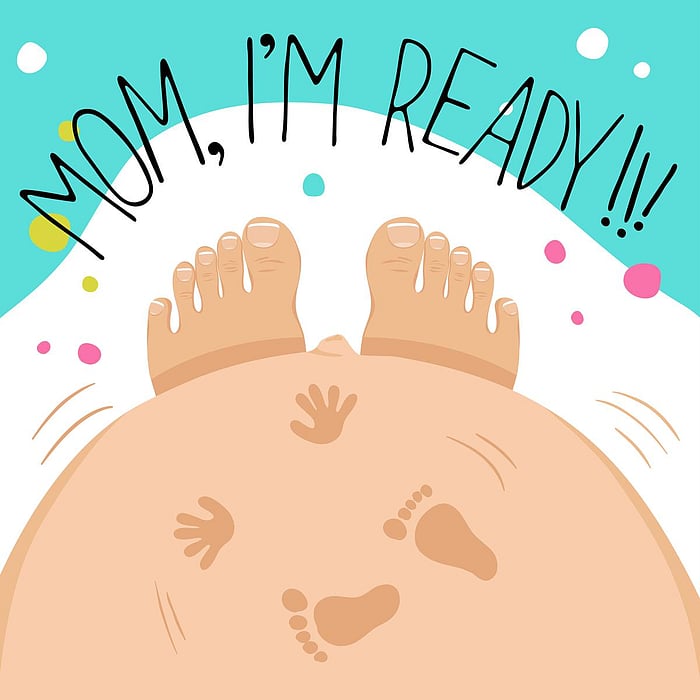The Most Common Signs of Labor, According to an Ob-Gyn

If you’re pregnant and your due date is fast approaching, it’s important to be able to recognize the signs that you’re dilating and in labor.
To help you better understand the stages of labor, the signs of early and true labor and the differences between true labor and Braxton Hicks contractions, Dr. Erin Higgins, an ob-gyn at the Cleveland Clinic, will walk you through the process.
Stages of labor
According to StatPearls, there are three stages of labor:
- Stage 1 begins when labor starts and ends when your cervix is fully dilated.
- Stage 2 begins with full cervical dilation and ends with the delivery of your baby.
- Stage 3 begins with the delivery of your baby and ends with the delivery of your placenta.
The first stage of labor is further broken down into two phases: the latent phase, sometimes called early labor, and the active, or true labor, phase.
Signs of early labor
Dilation
One of the early signs of labor is called dilation, which is when your cervix stretches to make room for the baby, according to the Cleveland Clinic. Dilation is measured in centimeters.
“When we talk about active labor versus latent labor…it's the difference between when you're less than 6 centimeters [in latent labor] and more than 6 centimeters [in active labor],” Higgins explained.
Mild, irregular contractions
Higgins said contractions are one of the “classic signs” of labor and can show up as mild cramping in the latent phase. She recommended calling the hospital if you’re experiencing any type of contraction.
“I can kind of assess over the phone to determine like, oh, this is likely early labor. Keep watching at home until the contractions get a certain strength or time apart frequency,” she said.
Water breaks
The U.S. National Library of Medicine says that when the amniotic sac that holds the baby inside the uterus breaks open, the water that filled that sac is released through your vagina.
Higgins noted that “with the water breaking, talking about a full term-pregnancy, we're going to admit you and have a baby once we do the physical exam to confirm that the water has broken.”
Bloody show
Bloody show is one of the signs you’re dilating, according to the Library of Medicine. You might notice a brown discharge and see the mucous plug, which keeps the cervix sealed during pregnancy.
Is nausea a sign of labor?
Wonderbaby.org notes that when your body gets ready for labor, blood is moved away from the digestive system to muscles, and this may lead to some feelings of nausea.
“Nausea is kind of another one of those things that's super common throughout pregnancy,” Higgins explained. “I would say that it's not necessarily a sign of labor, but again, something you can always call and ask about.”
Signs of active labor
Increased dilation
When your cervix is dilated 6-10 centimeters, you’re considered to be in the active or true phase of first-stage labor. While early labor dilation is slower, StatPearls says active labor dilation happens more quickly.
Regular contractions that increase in strength
In active labor, Higgins noted that your contractions strengthen and become more regular.
“Labor contractions, we tend to see anywhere from every two to three minutes, every four to five minutes regular,” she advised. “You can set your clock by it, and there's a lot of apps out there for people to monitor their contractions on.”
Diarrhea
A lot of people ask, is diarrhea a sign of labor? Higgins noted that some women do experience diarrhea during labor.
“I believe it's a hormonal effect … [due to] the prostaglandins,” she said.
Braxton Hicks contractions
“People can have Braxton Hicks contractions for several weeks leading up to true labor,” explained Higgins. “They're kind of referred to also as false labor.”
“I kind of differentiate from my patients saying, is it just kind of more annoying? It's not necessarily painful, it's not necessarily, it doesn't stop you [from doing]…what you're doing,” Higgins continued. “It's just kind of like, oh, OK, that's annoying. Whereas true labor contractions tend to stop you in your step.”
When to call your health care provider
If you experience any of the above signs of labor, Higgins said it’s important to call your health care provider. She also recommended contacting your ob-gyn if you think you’re experiencing preterm labor or a dangerous pregnancy condition called preeclampsia, which is marked by high blood pressure and protein in the urine.
“I would just say the signs of preterm labor are pretty much the signs of labor, happening prior to 37 weeks [of pregnancy],” Higgins said. “The symptoms of preeclampsia can be an unrelenting … headache, spots or floaters in the vision and pain in the upper belly, more so on the right side.
“Just whenever somebody's feeling kind of crummy at the end of pregnancy, it's generally good to touch base with your doctor just to find out and make sure everything's OK, that there's nothing that needs to be checked out,” she advised.
Resources
Erin Higgins, MD, ob-gyn, Cleveland Clinic
StatPearls: Stages of Labor
The Cleveland Clinic: Labor & Delivery
U.S. National Library of Medicine: Am I in Labor?
Wonderbaby.org: Is Nausea a Sign of Labor? 7 Signs & Symptoms to Watch For
Related Posts
Fibroids, Endometriosis Tied to Higher Ovarian Cancer Risk
MONDAY, May 15, 2023 (HealthDay News) -- Fibroids are associated with an...
How Many Daily Steps Do You Need to Lose Weight?
MONDAY, Jan. 30, 2023 (HealthDay News) -- It’s clear that staying active is key...
Los frágiles egos masculinos hacen que muchas mujeres ‘finjan’ en la cama
MIÉRCOLES, 2 de febrero de 2022 (HealthDay News) -- Tres nuevos estudios están...
Review: Power Training, Strength Training Compared for Older Adults
WEDNESDAY, May 11, 2022 (HealthDay News) -- For older adults, power training...
